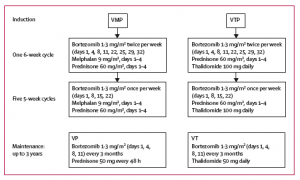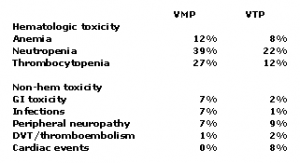What’s the best treatment for elderly patients with untreated multiple myeloma?
It’s a while since I’ve written about multiple myeloma, but after this interesting paper popped up in The Lancet Oncology, I couldn’t resist.
Many cancers occur more frequently in the elderly, a testament to the extended lifestyle many of us now enjoy compared to ancient times. This offers many challenges compared to treating younger fitter people, not least are performance status and managing toxicities.
A standard induction treatment in untreated multiple myeloma is now the combination of bortezomib (Velcade), melphalan and prednisone (VMP), which has been shown to be superior to MP alone. In elderly people with multiple myeloma, however, the side effects can be difficult to tolerate.
A Spanish group has considered this challenge and investigated whether a different regimen would be as effective but less intensive, thereby offering an alternative option for elderly multiple myeloma patients.
What they did was really interesting. The used bortezomib, thalidomide and prednisone (VTP) as induction therapy compared with the standard VMP followed by maintenance treatment with either bortezomib and thalidomide (VT) or bortezomib and prednisone (VP).
Here’s the treatment schedule:

The efficacy results were encouraging:
Induction: VMP VTP
PR 81% 80%
CR 28% 20%
Maintenance: BT BP
CR 44% 39%
What about the side effect profile?

Overall, there was less neutropenia and thrombocytopenia in the VTP group (good news), but slightly increased cardiac events. It is also interesting to note that peripheral neuropathy (hand and foot syndrome), one of the side effects of bortezomib treatment had a relatively low incidence (less than 10%) in both groups.
Overall survival was, however, superior in the VMP group (34 months) compared with the VTP group (25 months).
As always, it is ultimately a delicate balancing act between efficacy, survival and side effects, depending of the patient’s treatment goals. The authors reasonably concluded:
“Reduced-intensity induction with a bortezomib-based regimen, followed by maintenance, is a safe and effective treatment for elderly patients with multiple myeloma.”
![]()
Mateos MV, Oriol A, Martínez-López J, Gutiérrez N, Teruel AI, de Paz R, García-Laraña J, Bengoechea E, Martín A, Mediavilla JD, Palomera L, de Arriba F, González Y, Hernández JM, Sureda A, Bello JL, Bargay J, Peñalver FJ, Ribera JM, Martín-Mateos ML, García-Sanz R, Cibeira MT, Ramos ML, Vidriales MB, Paiva B, Montalbán MA, Lahuerta JJ, Bladé J, & Miguel JF (2010). Bortezomib, melphalan, and prednisone versus bortezomib, thalidomide, and prednisone as induction therapy followed by maintenance treatment with bortezomib and thalidomide versus bortezomib and prednisone in elderly patients with untreated multiple myelom The lancet oncology, 11 (10), 934-41 PMID: 20739218
One Response to “What’s the best treatment for elderly patients with untreated multiple myeloma?”
[…] This post was mentioned on Twitter by ResearchBlogging.org and scienceblogsRSS, Flipboard Science. Flipboard Science said: What’s the best treatment for elderly patients with untreated multiple myeloma? http://bit.ly/9kJAfC […]
Comments are closed.